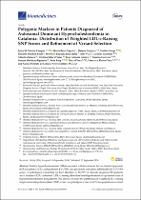| dc.contributor | Institut d'Assistència Sanitària |
| dc.contributor.author | Martín-Campos, Jesús Maria |
| dc.contributor.author | Ruiz-Nogales, Sheila |
| dc.contributor.author | Ortega, Emilio |
| dc.contributor.author | Sánchez-Pujol, Elisabet |
| dc.contributor.author | Royuela Juncadella, Meritxell |
| dc.contributor.author | Vila, Àlex |
| dc.contributor.author | Guerrero, Carolina |
| dc.contributor.author | Zamora, Alberto |
| dc.contributor.author | Soler, Cristina |
| dc.contributor.author | Ibarretxe, Daiana |
| dc.date.accessioned | 2022-02-09T14:23:50Z |
| dc.date.available | 2022-02-09T14:23:50Z |
| dc.date.issued | 2020-09-15 |
| dc.identifier.citation | Martín-Campos JM, Ruiz-Nogales S, Ibarretxe D, Ortega E, Sánchez-Pujol E, Royuela-Juncadella M, et al. Polygenic Markers in Patients Diagnosed of Autosomal Dominant Hypercholesterolemia in Catalonia: Distribution of Weighted LDL-c-Raising SNP Scores and Refinement of Variant Selection. Biomedicines. 2020 Sep 15;8(9):353. |
| dc.identifier.issn | 2227-9059 |
| dc.identifier.uri | https://hdl.handle.net/11351/6995 |
| dc.description | Familial hypercholesterolemia; Atherosclerosis; Genetic risk scores |
| dc.description.abstract | Familial hypercholesterolemia (FH) is associated with mutations in the low-density lipoprotein (LDL) receptor (LDLR), apolipoprotein B (APOB), and proprotein convertase subtilisin/kexin 9 (PCSK9) genes. A pathological variant has not been identified in 30–70% of clinically diagnosed FH patients, and a burden of LDL cholesterol (LDL-c)-raising alleles has been hypothesized as a potential cause of hypercholesterolemia in these patients. Our aim was to study the distribution of weighted LDL-c-raising single-nucleotide polymorphism (SNP) scores (weighted gene scores or wGS) in a population recruited in a clinical setting in Catalonia. The study included 670 consecutive patients with a clinical diagnosis of FH and a prior genetic study involving 250 mutation-positive (FH/M+) and 420 mutation-negative (FH/M−) patients. Three wGSs based on LDL-c-raising variants were calculated to evaluate their distribution among FH patients and compared with 503 European samples from the 1000 Genomes Project. The FH/M− patients had significantly higher wGSs than the FH/M+ and control populations, with sensitivities ranging from 42% to 47%. A wGS based only on the SNPs significantly associated with FH (wGS8) showed a higher area under the receiver operating characteristic curve, and higher diagnostic specificity and sensitivity, with 46.4% of the subjects in the top quartile. wGS8 would allow for the assignment of a genetic cause to 66.4% of the patients if those with polygenic FH are added to the 37.3% of patients with monogenic FH. Our data indicate that a score based on 8 SNPs and the75th percentile cutoff point may identify patients with polygenic FH in Catalonia, although with limited diagnostic sensitivity and specificity |
| dc.language.iso | eng |
| dc.publisher | MDPI |
| dc.relation.ispartofseries | Biomedicines;8(9) |
| dc.rights | Attribution 4.0 International |
| dc.rights.uri | https://creativecommons.org/licenses/by/4.0/ |
| dc.source | Scientia |
| dc.subject | Colesterolèmia - Catalunya |
| dc.subject | Lipoproteïnes de densitat baixa - Receptors |
| dc.subject | Hiperlipoproteïnèmia - Catalunya |
| dc.subject.mesh | Cholesterol, LDL |
| dc.subject.mesh | Receptors, LDL |
| dc.subject.mesh | Hyperlipoproteinemia Type II |
| dc.subject.mesh | Catalonia |
| dc.title | Polygenic Markers in Patients Diagnosed of Autosomal Dominant Hypercholesterolemia in Catalonia: Distribution of Weighted LDL-c-Raising SNP Scores and Refinement of Variant Selection |
| dc.type | info:eu-repo/semantics/article |
| dc.identifier.doi | 10.3390/biomedicines8090353 |
| dc.subject.decs | colesterol LDL |
| dc.subject.decs | hipercolesterolemia familiar |
| dc.subject.decs | receptores de LDL |
| dc.subject.decs | Cataluña |
| dc.relation.publishversion | https://doi.org/10.3390/biomedicines8090353 |
| dc.type.version | info:eu-repo/semantics/publishedVersion |
| dc.audience | Professionals |
| dc.event.productor | Biblioteca |
| dc.contributor.authoraffiliation | [Martín-Campos J] Grup de Bases Metabòliques del Risc Cardiovascular, Institut d'Investigació de l'Hospital Santa Creu i Sant Pau (IR-HSCSP), Institut d'Investigació Biomèdica de Sant Pau (IIB-Sant Pau), Barcelona, Spain. Centre Espanyol d'Investigació Biomèdica en Diabetis i Trastorns Metabòlics Associats (CIBERDEM), Madrid, Spain. [Ruiz-Nogales S] Grup de Bases Metabòliques del Risc Cardiovascular, Institut d'Investigació de l'Hospital Santa Creu i Sant Pau (IR-HSCSP). Institut d'Investigació Biomèdica de Sant Pau (IIB-Sant Pau), Barcelona, Spain. [Ibarretxe D] Investigació Biomèdica Espanyola Centre de Diabetis i Trastorns Metabòlics Associats (CIBERDEM), Madrid, Spain. Unitat de Recerca en Lípids i Aterosclerosi, Unitat de Medicina Vascular i Metabolisme, Hospital Universitari Sant Joan, Universitat Rovira i Virgili, Institut d'Investigació Sanitària Pere Virgili (IISPV), Reus, Spain. [Ortega E] Servei d'Endocrinologia i Nutrició, Hospital Clínic, Barcelona, Spain. Centre Espanyol d'Investigació Biomèdica en Fisiopatologia de l'Obesitat i la Nutrició (CIBEROBN), Madrid, Spain. [Sánchez-Pujol E] Servei de Medicina Interna, Hospital-Asil de Granollers, Granollers, Barcelona, Spain. [Royuela-Juncadella M] Servei de Medicina Interna, Altahia, Xarxa Assistencial Universitària de Manresa, Manresa, Spain. [Vila A] Servei de Medicina Interna, Hospital de Figueres, Figueres, Spain. [Guerrero C] Servei de Medicina Interna, Hospital de Terrassa, Consorci Sanitari de Terrassa, Terrassa, Spain. Servei de Medicina Interna, Hospital Sant Joan de Déu de Martorell, Martorell, Spain. [Zamora A] Servei de Medicina Interna, Corporació de Salut del Maresme i La Selva, Hospital de Blanes, Blanes, Spain. [Soler-Ferrer C] Servei de Medicina Interna, Hospital Santa Caterina, Institut d’Assistència Sanitària(IAS), Salt, Spain |
| dc.identifier.pmid | 32942679 |
| dc.rights.accessrights | info:eu-repo/semantics/openAccess |

 Private area
Private area Contact Us
Contact Us







